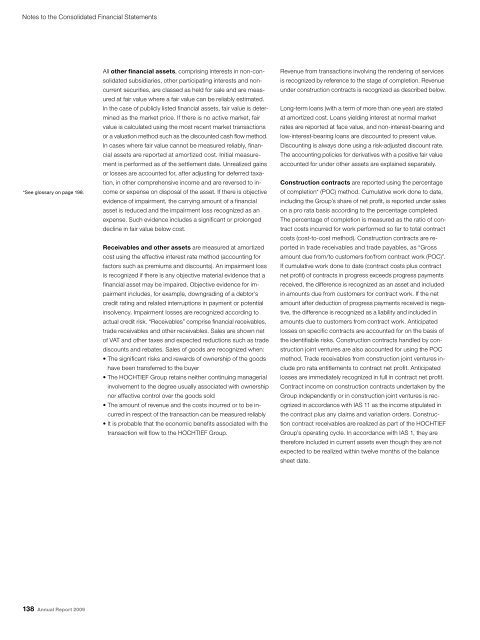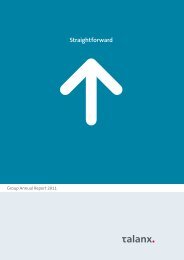ONE ROOF
ONE ROOF
ONE ROOF
Create successful ePaper yourself
Turn your PDF publications into a flip-book with our unique Google optimized e-Paper software.
Notes to the Consolidated Financial Statements<br />
*See glossary on page 198.<br />
138 Annual Report 2009<br />
All other financial assets, comprising interests in non-con-<br />
solidated subsidiaries, other participating interests and noncurrent<br />
securities, are classed as held for sale and are measured<br />
at fair value where a fair value can be reliably estimated.<br />
In the case of publicly listed financial assets, fair value is determined<br />
as the market price. If there is no active market, fair<br />
value is calculated using the most recent market transactions<br />
or a valuation method such as the discounted cash flow method.<br />
In cases where fair value cannot be measured reliably, financial<br />
assets are reported at amortized cost. Initial measurement<br />
is performed as of the settlement date. Unrealized gains<br />
or losses are accounted for, after adjusting for deferred taxation,<br />
in other comprehensive income and are reversed to income<br />
or expense on disposal of the asset. If there is objective<br />
evidence of impairment, the carrying amount of a financial<br />
asset is reduced and the impairment loss recognized as an<br />
expense. Such evidence includes a significant or prolonged<br />
decline in fair value below cost.<br />
Receivables and other assets are measured at amortized<br />
cost using the effective interest rate method (accounting for<br />
factors such as premiums and discounts). An impairment loss<br />
is recognized if there is any objective material evidence that a<br />
financial asset may be impaired. Objective evidence for impairment<br />
includes, for example, downgrading of a debtor’s<br />
credit rating and related interruptions in payment or potential<br />
insolvency. Impairment losses are recognized according to<br />
actual credit risk. “Receivables” comprise financial receivables,<br />
trade receivables and other receivables. Sales are shown net<br />
of VAT and other taxes and expected reductions such as trade<br />
discounts and rebates. Sales of goods are recognized when:<br />
• The significant risks and rewards of ownership of the goods<br />
have been transferred to the buyer<br />
• The HOCHTIEF Group retains neither continuing managerial<br />
involvement to the degree usually associated with ownership<br />
nor effective control over the goods sold<br />
• The amount of revenue and the costs incurred or to be incurred<br />
in respect of the transaction can be measured reliably<br />
• It is probable that the economic benefits associated with the<br />
transaction will flow to the HOCHTIEF Group.<br />
Revenue from transactions involving the rendering of services<br />
is recognized by reference to the stage of completion. Revenue<br />
under construction contracts is recognized as described below.<br />
Long-term loans (with a term of more than one year) are stated<br />
at amortized cost. Loans yielding interest at normal market<br />
rates are reported at face value, and non-interest-bearing and<br />
low-interest-bearing loans are discounted to present value.<br />
Discounting is always done using a risk-adjusted discount rate.<br />
The accounting policies for derivatives with a positive fair value<br />
accounted for under other assets are explained separately.<br />
Construction contracts are reported using the percentage<br />
of completion* (POC) method. Cumulative work done to date,<br />
including the Group’s share of net profit, is reported under sales<br />
on a pro rata basis according to the percentage completed.<br />
The percentage of completion is measured as the ratio of contract<br />
costs incurred for work performed so far to total contract<br />
costs (cost-to-cost method). Construction contracts are reported<br />
in trade receivables and trade payables, as “Gross<br />
amount due from/to customers for/from contract work (POC)”.<br />
If cumulative work done to date (contract costs plus contract<br />
net profit) of contracts in progress exceeds progress payments<br />
received, the difference is recognized as an asset and included<br />
in amounts due from customers for contract work. If the net<br />
amount after deduction of progress payments received is negative,<br />
the difference is recognized as a liability and included in<br />
amounts due to customers from contract work. Anticipated<br />
losses on specific contracts are accounted for on the basis of<br />
the identifiable risks. Construction contracts handled by construction<br />
joint ventures are also accounted for using the POC<br />
method. Trade receivables from construction joint ventures include<br />
pro rata entitlements to contract net profit. Anticipated<br />
losses are immediately recognized in full in contract net profit.<br />
Contract income on construction contracts undertaken by the<br />
Group independently or in construction joint ventures is recognized<br />
in accordance with IAS 11 as the income stipulated in<br />
the contract plus any claims and variation orders. Construction<br />
contract receivables are realized as part of the HOCHTIEF<br />
Group’s operating cycle. In accordance with IAS 1, they are<br />
therefore included in current assets even though they are not<br />
expected to be realized within twelve months of the balance<br />
sheet date.
















